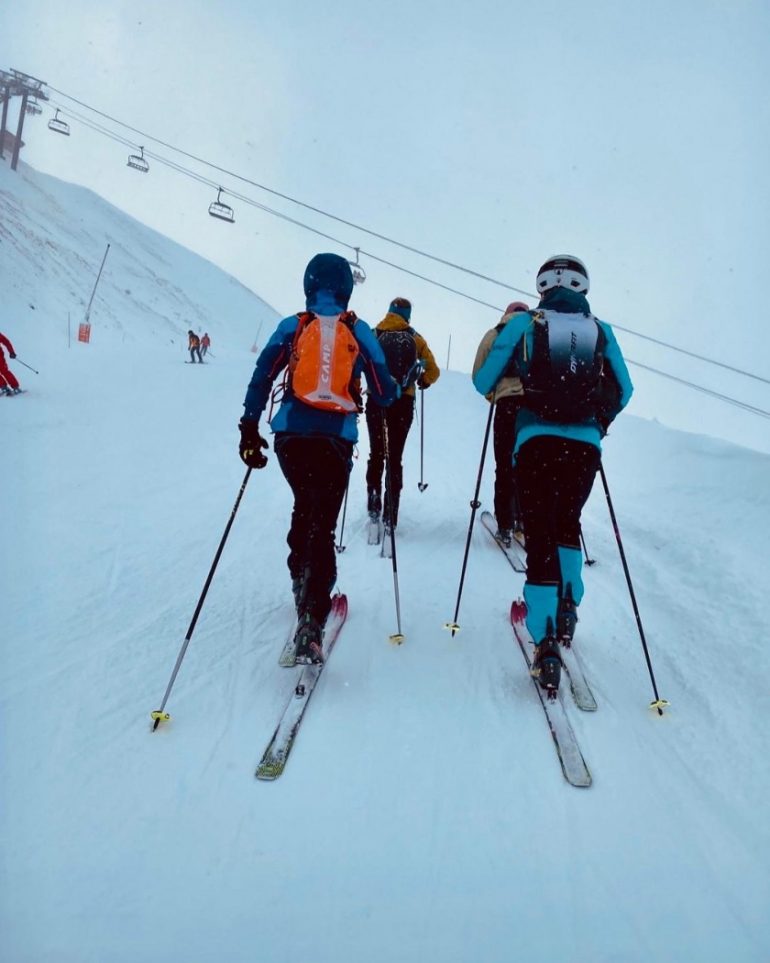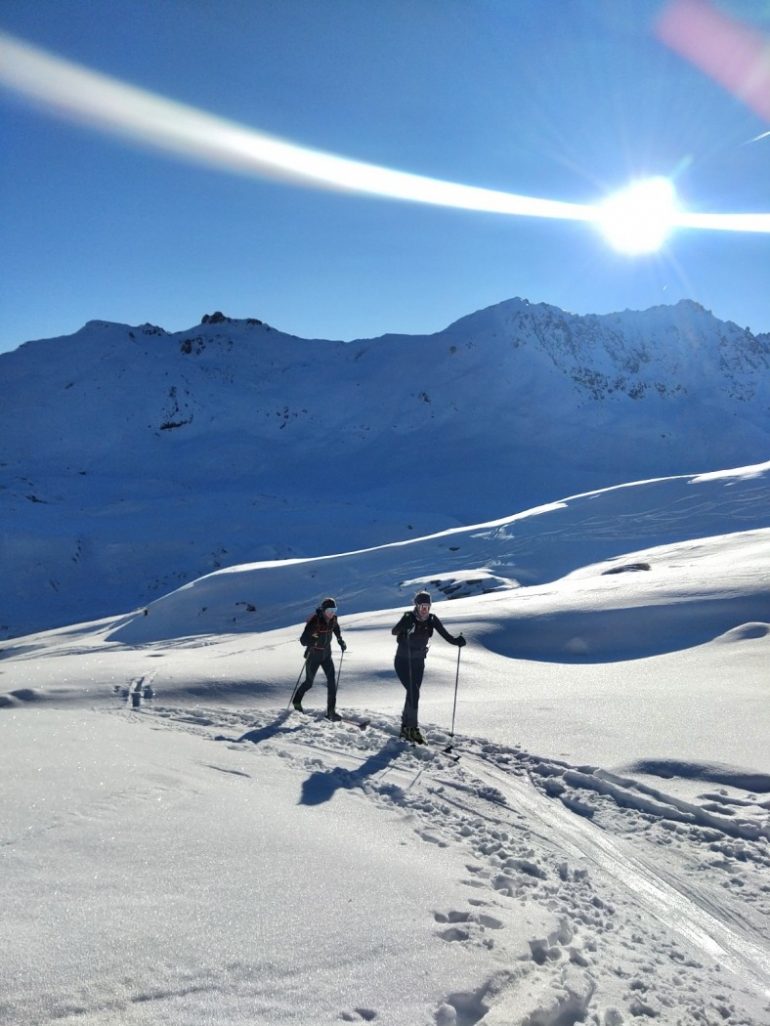
The hustle of skimo season includes social skis while logging vert.
Here’s the thing about a niche sport like skimo: no one really knows what they’re doing. As fall rolls around and athletes transition from their summer sport to their spandex-heavy, frostbite-ridden, winter passion project, they all do so differently. Some athletes, IE those particularly competitive on the international running scene, have races late into the fall, meaning their running spans most of their “pre-season training” period. For others, they choose to transition to hiking with poles and finding variable snow as quickly as possible. But, over in Europe, I’ve noticed that I’m far from the only one spending time skiing on the glacier to get time on skis before the race season begins.
Imagine this; it’s the first race of the season, you pull together your ski gear in a haphazard way after digging it out of the closet where it’s rested all summer. You drive to the local hill and find yourself on a frozen startline alongside other locals crazy enough to ski uphill before work. The gun goes off, or more likely, a ski patroller yells “Go!” and before long you’re tasting pennies and wondering why the fire burning in your lungs can’t keep you warm. Now imagine this, it’s no longer your first day on skis. You’re still tasting pennies, but you can go a little bit harder, and a little bit faster, despite the copper taste. Now I realize that I am incredibly fortunate to be able to travel to find snow at the glacier this time of year. While the European Teams have traveled to find snow in a few hotspots (Tignes, Zermatt, Saas Fey, Stelvio, the list goes on,) I’ve been encouraged by my fellow racers back home getting creative with their early-season training. There is something special that I find myself missing about the flat fall skimo laps on one particular mining road outside of Breckenridge, Colorado.
This fall, instead of Sallie Barber Road back in Summit County, I’m training out of Tignes, France. With three consecutive French Cup race weekends beginning the weekend of November 27th, and the first ISMF World Cup in Ponte di Legno on December 16th, my proper pre-season training is coming to a close. With nearly six weeks of skimo specific training to absorb, now I’m thinking about the transition from building a base on skis, to preparing for the race season. So, you may wonder, what does training look like before race season begins?

Alps, blue skis, altitude…it is still called training.
Strength Training + Mobility
As someone who primarily runs in the summer, you can imagine that come time for ski season, I benefit by building muscle and a bit of ski-specific strength. Time in the gym helps me feel more powerful and explosive in short sprint races, and more durable and safe in the long (and sometimes sketchy) descents of team and individual races. As my body acclimates from the more dynamic trail running movements to the somewhat monotonous movements on skimo skis, I also find it helpful to focus on mobility work and plyometrics to keep everything working right and feeling good! There’s nothing quite like incredibly sore hip flexors after your first flat ski of the season (at least for me, the glide-heavy terrain is guaranteed to make me sore in October and November).
Distance/Volume on Skis (still giving running a bit of love)
The fall is also a great time to put in some volume on skis to build a more specific base. After a summer of outdoor recreation, you may have great fitness, but skiing is a different movement and a different sport. Getting in quality sessions on skis, with plenty of vertical but a focus on good form and technique, helps me to feel confident that when I start adding intensity, my body will have the fitness and endurance to back it up.
Here in Tignes, I’ve motored up the same ski run up the Grande Motte Glacier countless times, but I’ve always found a special sense of comfort immersed in early season hamster laps. Base building is highly individualized, and while I’ve always been an athlete who thrives on high volume training, early-season distance days likely look a little different for everyone. Even if it means getting out and skinning for two hours, a focus on good form, technique and keeping it easy pays dividends in the long run.
First Intensity Sessions of the Season
While most of my training sessions over the course of a week consist of easy volume, I also work in my first intensity workouts of the season. The first few times I try to go hard on skis, it’s inevitably a bit of a dumpster fire. The muscular endurance to sustain that kind of uphill effort on skis is a bit different than the strength required to run fast uphill, and man-oh-man, do my legs burn. Luckily, a few weeks in, those twice-weekly interval sessions feel more productive as I find myself able to raise my heart rate higher and find a pace closer to race pace. In addition to being a great opportunity to improve your fitness for race season, intervals are a great excuse to get out with friends and work. The type of work that is always best followed up by a cookie and coffee when you hit stop on your watch.
Specific Skills: Transitions, Kickturns, Technique
Fitness and endurance are crucial as a skimo racer. You have to be in top-notch shape, able to meet incredible demands skiing both uphill and down. However, when the margins are as small as they tend to be in competitive races like World Cups, skimo’s technical components can be the difference between a win and the step down on the podium. With Laeti able to spend time with me in Tignes this year I’ve been beyond grateful to pick her brain on all things skill related. While I know her affectionately as Laeti, Laetitia Roux is perhaps the most accomplished skimo racer of all time. She has 17 World Champion titles, 64 World Cup wins and has stood atop the podium at a Grande Course more than 20 times with various partners. Needless to say, I have much to learn, and in the past three years of working with her there’s been no shortage of education and improvement.
We’ve spent hours working transitions on our homemade sprint courses — we try and always make kickturns just off-piste instead of the groomer to work more variable snow and I’ve found myself on the cross-country slopes more than once to make my glide technique, “less bad” as Laeti would put it. While I certainly am not advocating for only skills work, I will always advocate for working it in whenever possible. Whether it be 15 minutes of transitions in your living room while watching TV, or a day at the cross-country hill to work on that kick and glide, skills are where it’s at for a sport like skimo!
The pre-season has been productive for me. While training with the other teams here on the glacier and working with Laeti, I’ve found myself challenged to work on my deficiencies. Not only have I been putting in the hard work by going out for six-hour ski days, climbing 12,000 feet of vertical in the process, but I’ve been working on snappy transitions, smooth glide technique, improving my skiing, and mastering the infamous kickturn. I think it’s important to keep in mind that at the end of the day, our season is long! I will be racing until the finish line at the PDG at the end of April and I need to be excited and motivated to race until then. So, perhaps the most important pillar of early season training is stoking the fire for the winter and having a blast getting out on skis. Whether your fall training has been on the local forest road, running trails, in the gym, or at a ski resort lucky enough to open before Thanksgiving, I hope it’s been full of excitement for winter. I know in Tignes that’s certainly the mindset, and for that, I couldn’t be more grateful.
Nineteen-year-old Grace Staberg is a student at the London School of Economics and flies uphill on the skimo World Cup. She recently settled in France and will be writing about her experiences for WildSnow this season.
Grace Staberg grew up in Silverthorne, Colorado and races both domestically and internationally as a trail runner and skimo athlete. She races the ISMF Skimo World Cup circuit in the winter, and when not racing, can be found on long adventures in the mountains. She is the North American Record Holder for most vertical feet ascended in 24-hours and enjoys nothing more than a good sufferfest. Alongside athletic goals, she is studying Economics and Finance at the London School of Economics. Grace is also passionate about mental health advocacy, mentorship of young athletes in sport and helping others to find as much joy and gratitude in the mountains as she does.
